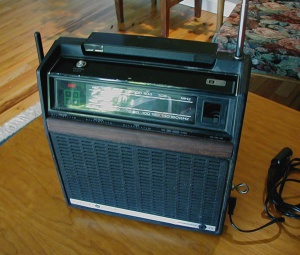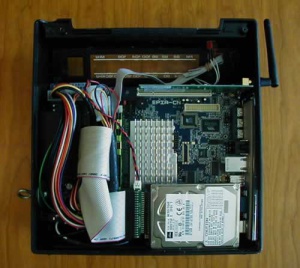8track: Difference between revisions
Brian Wilson (talk | contribs) mNo edit summary |
Brian Wilson (talk | contribs) |
||
| Line 42: | Line 42: | ||
==Pictures== | ==Pictures== | ||
[[Image:8track.jpg|thumb]] | [[Image:8track.jpg|thumb|left|Exterior view of 8track]] | ||
[[Image:8track_interior.jpg|thumb]] | |||
A wood strip is fitted to cover over slots left when I removed the various controls (volume, tone and so on.) It fits the style of cases of this vintage though it's real hardwood not contact paper! | |||
<br clear=all> | |||
[[Image:8track_interior.jpg|thumb|left|View inside with back cover removed]] | |||
Here you can see the interior layout. | |||
There is enough room at the top of the case to accomodate an LCD display. | |||
The Trendnet Wifi card fit in easily once I removed its card slot adapter. | |||
I used a router to enlarge the 8-track slot to fit the mainboard back panel. | |||
The styrene plastic is very easy and clean to work with a carbide bit. I probably won't get cancer for many more years. | |||
The large metal ring on the left is an eye bolt to allow me to lock down the case when I leave it unattended in public places. | |||
Revision as of 21:07, 3 August 2006
My quest for low power systems began in my Carbon diet page and now continues with this system. It is smaller, faster, and uses less energy than the earlier Via EPIA 800 system which I am still currently using as a server at home.
When I was riding around Corvallis one day, I saw a free pile in front of someone's house. Right on top was a GE portable AM/FM 8 track player. I could not pass it up. I immediately envisioned putting a computer in the case and that is exactly what happened.
I realize now that I could probably have sold it for $10 on Ebay! Well, I have gotten more than $10 worth of entertainment out of it so far.
I used 8track as the unofficial [Solar CREEK kiosk] at DaVinci Days.
Hardware specs
"8track" is now a complete computer system based on a Via CN10000 Mini-ITX board built inside the 8 track player case. It has
- 1GB of DDR2 RAM,
- a 30 GB Toshiba IDE drive borrowed from a Toshiba Magnia SG20
- a Morex 60 watt automotive power supply
- a Trendnet WiFi PCI card
Power options include using either an old HP Omnibook 800 laptop power supply or a 12 volt gel cell. At the Solar CREEK booth at DaVinci Days, I ran it on a solar panel and a 120 vac inverter.
I used the 2.5" drive because the Morex will not support the power requirements of a 3.5" drive on its 12V output. The Tosh drive is IDE (PATA) and plugs into a 44-40 pin adapter. I will put the SATA drive currently in Iris into it if I ever upgrade Iris to a faster drive.
I can plug it into any convenient monitor and keyboard. At DaVinci days, I used an Acer 15" display and a PS/2 keyboard and mouse. The monitor ran off the inverter, too. I plugged in stereo speakers and connected to the Solar CREEK web site via a wireless link.
The HP power supply puts out about 35 watts and it had no trouble running this machine in the above configuration. I measured output of the supply and found it takes about 10 watts to run.
Software
I am running Ubuntu Linux on it at the moment (6.06/Dapper Drake).
MPEG-2 playback
This is intended to be a full multimedia machine. I use alsaplayer for audio files and I use mplayer to play the official Solar CREEK quicktime video. There is currently a problem with decoding quicktime because it's too new. The support for the hardware MPEG player is not there yet. Video playback speed varies slightly. No one but me notices it.
Where is it now?
Currently 8track is in the corner unused, as I have 57 other projects stacked up. My laptop Iris is at the top of the list today.
I want to get some accurate power measurement equipment pieced together before I go any further with the Carbon diet so 8track is on hold for the moment.
Pictures

A wood strip is fitted to cover over slots left when I removed the various controls (volume, tone and so on.) It fits the style of cases of this vintage though it's real hardwood not contact paper!

Here you can see the interior layout.
There is enough room at the top of the case to accomodate an LCD display. The Trendnet Wifi card fit in easily once I removed its card slot adapter.
I used a router to enlarge the 8-track slot to fit the mainboard back panel. The styrene plastic is very easy and clean to work with a carbide bit. I probably won't get cancer for many more years.
The large metal ring on the left is an eye bolt to allow me to lock down the case when I leave it unattended in public places.